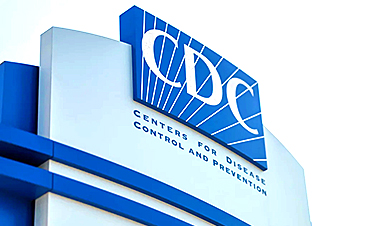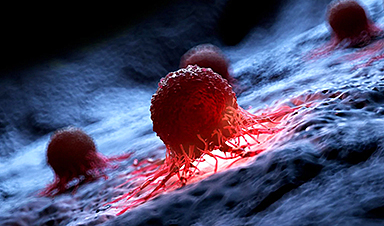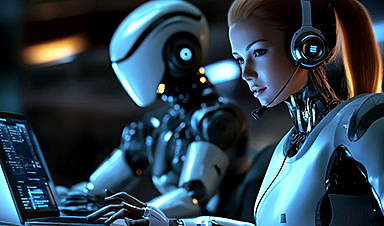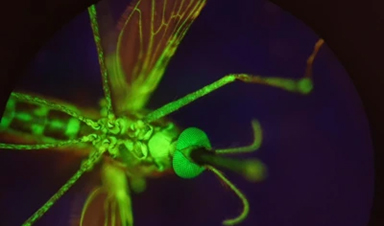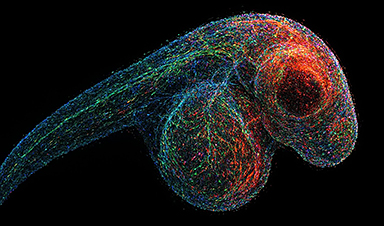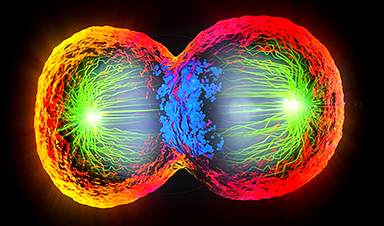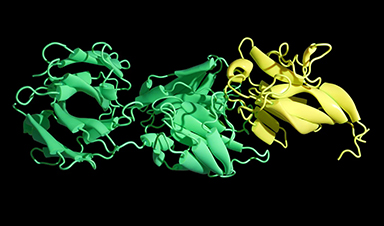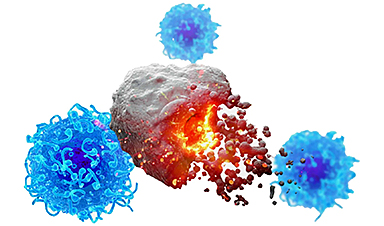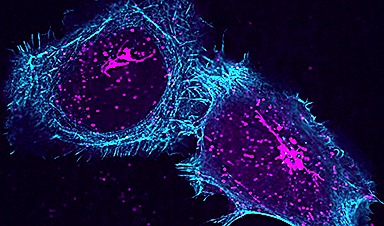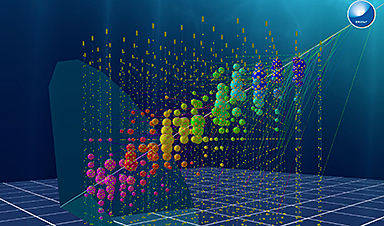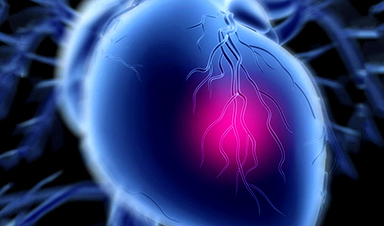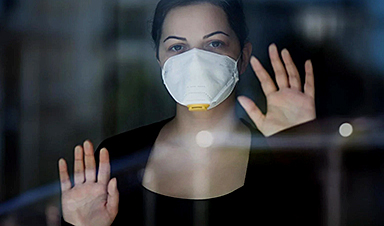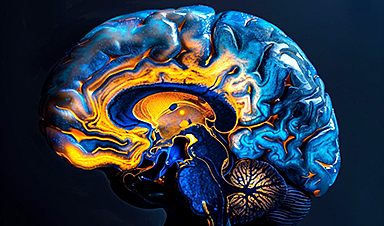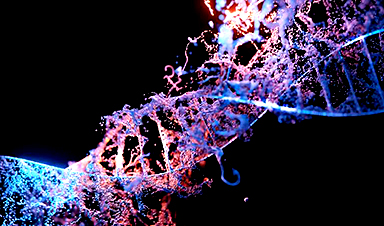| Scientists have worked out how to best get DNA to communicate with membranes in our body, paving the way for the creation of ‘mini biological computers’ in droplets that have potential uses in biosensing and mRNA vaccines. | |
| UNSW’s Dr Matthew Baker and the University of Sydney’s Dr Shelley Wickham co-led the study, published recently in Nucleic Acids Research (“Binding of DNA origami to lipids: maximizing yield and switching via strand displacement”). | |
| It discovered the best way to design and build DNA ‘nanostructures’ to effectively manipulate synthetic liposomes – tiny bubbles which have traditionally been used to deliver drugs for cancer and other diseases. | |
| But by modifying the shape, porosity and reactivity of liposomes, there are far greater applications, such as building small molecular systems that sense their environment and respond to a signal to release a cargo, such as a drug molecule when it nears its target. |
| Lead author Dr Matt Baker from UNSW’s School of Biotechnology and Biomolecular Sciences says the study discovered how to build “little blocks” out of DNA and worked out how best to label these blocks with cholesterol to get them to stick to lipids, the main constituents of plant and animal cells. | |
| “One major application of our study is biosensing: you could stick some droplets in a person or patient, as it moves through the body it records local environment, processes this and delivers a result so you can ‘read out’, the local environment,” Dr Baker says. | |
| Liposome nanotechnology has shot into prominence with the use of liposomes alongside RNA vaccines such as the Pfizer and Moderna COVID-19 vaccines. | |
| “This work shows new ways to corral liposomes into place and then pop them open at just the right time,” Dr Baker says. | |
| “What’s better is because they are built from the bottom-up out of individual parts we design, we can easily bolt in and out different components to change the way they work. | |
| Previously scientists struggled to find the right buffer conditions for lipids and liposomes to make sure that their DNA ‘computers’ actually stuck to liposomes. | |
| They also struggled with the best way to decorate the DNA with cholesterols so that it would not only go to the membrane but stay there as long as was needed. | |
| “Is it better at the edge? The centre? Heaps of them? Few of them? Close as possible to structure, or far as possible?,” Dr Baker says. | |
| “We looked at all these things and showed that we could make good conditions for DNA structures to bind to liposomes reliably and ‘do something’.” | |
| Dr Baker says membranes are critical in life as they allow compartments to form and therefore different types of tissue and cells to be separated. | |
| “This all relies on membranes being generally quite impermeable,” he says. | |
| “Here we have built totally new DNA nanotechnology where we can punch holes in membranes, on demand, to be able to pass important signals across a membrane. | |
| “This is ultimately the basis in life of how cells communicate with each other, and how something useful can be made in one cell and then exported to be used elsewhere.” | |
| Alternately, in pathogens, membranes can be disrupted to destroy cells, or viruses can sneak into cells to replicate themselves. | |
| The scientists will next work on how to control DNA-based pores that can be triggered with light to develop synthetic retinas out of entirely novel parts. |
News
The CDC buried a measles forecast that stressed the need for vaccinations
This story was originally published on ProPublica, a nonprofit newsroom that investigates abuses of power. Sign up to receive our biggest stories as soon as they’re published. ProPublica — Leaders at the Centers for Disease Control and Prevention [...]
Light-Driven Plasmonic Microrobots for Nanoparticle Manipulation
A recent study published in Nature Communications presents a new microrobotic platform designed to improve the precision and versatility of nanoparticle manipulation using light. Led by Jin Qin and colleagues, the research addresses limitations in traditional [...]
Cancer’s “Master Switch” Blocked for Good in Landmark Study
Researchers discovered peptides that permanently block a key cancer protein once thought untreatable, using a new screening method to test their effectiveness inside cells. For the first time, scientists have identified promising drug candidates [...]
AI self-cloning claims: A new frontier or a looming threat?
Chinese scientists claim that some AI models can replicate themselves and protect against shutdown. Has artificial intelligence crossed the so-called red line? Chinese researchers have published two reports on arXiv claiming that some artificial [...]
New Drug Turns Human Blood Into Mosquito-Killing Weapon
Nitisinone, a drug for rare diseases, kills mosquitoes when present in human blood and may become a new tool to fight malaria, offering longer-lasting, environmentally safer effects than ivermectin. Controlling mosquito populations is a [...]
DNA Microscopy Creates 3D Maps of Life From the Inside Out
What if you could take a picture of every gene inside a living organism—not with light, but with DNA itself? Scientists at the University of Chicago have pioneered a revolutionary imaging technique called volumetric DNA microscopy. It builds [...]
Scientists Just Captured the Stunning Process That Shapes Chromosomes
Scientists at EMBL have captured how human chromosomes fold into their signature rod shape during cell division, using a groundbreaking method called LoopTrace. By observing overlapping DNA loops forming in high resolution, they revealed that large [...]
Bird Flu Virus Is Mutating Fast – Scientists Say Our Vaccines May Not Be Enough
H5N1 influenza is evolving rapidly, weakening the effectiveness of existing antibodies and increasing its potential threat to humans. Scientists at UNC Charlotte and MIT used high-performance computational modeling to analyze thousands of viral protein-antibody interactions, revealing [...]
Revolutionary Cancer Vaccine Targets All Solid Tumors
The method triggers immune responses that inhibit melanoma, triple-negative breast cancer, lung carcinoma, and ovarian cancer. Cancer treatment vaccines have been in development since 2010, when the first was approved for prostate cancer, followed [...]
Scientists Uncover Hidden Protein Driving Autoimmune Attacks
Scientists have uncovered a critical piece of the puzzle in autoimmune diseases: a protein that helps release immune response molecules. By studying an ultra-rare condition, researchers identified ArfGAP2 as a key player in immune [...]
Mediterranean neutrino observatory sets new limits on quantum gravity
Quantum gravity is the missing link between general relativity and quantum mechanics, the yet-to-be-discovered key to a unified theory capable of explaining both the infinitely large and the infinitely small. The solution to this [...]
Challenging Previous Beliefs: Japanese Scientists Discover Hidden Protector of Heart
A Japanese research team found that the oxidized form of glutathione (GSSG) may protect heart tissue by modifying a key protein, potentially offering a novel therapeutic approach for ischemic heart failure. A new study [...]
Millions May Have Long COVID – So Why Can’t They Get Diagnosed?
Millions of people in England may be living with Long Covid without even realizing it. A large-scale analysis found that nearly 10% suspect they might have the condition but remain uncertain, often due to [...]
Researchers Reveal What Happens to Your Brain When You Don’t Get Enough Sleep
What if poor sleep was doing more than just making you tired? Researchers have discovered that disrupted sleep in older adults interferes with the brain’s ability to clean out waste, leading to memory problems [...]
How to prevent chronic inflammation from zombie-like cells that accumulate with age
In humans and other multicellular organisms, cells multiply. This defining feature allows embryos to grow into adulthood, and enables the healing of the many bumps, bruises and scrapes along the way. Certain factors can [...]
Breakthrough for long Covid patients who lost sense of smell
A breakthrough nasal surgery has restored the sense of smell for a dozen long Covid patients. Experts at University College London Hospitals NHS Foundation Trust successfully employed a technique typically used for correcting blocked nasal passages, [...]

